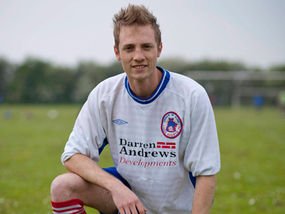I also had to give up my job in the building trade because I was on my feet all day, says Liam, who at the time had recently graduated from university.
Even to get out of the house I had to bathe my left foot in hot water to loosen up the muscles.
Heel pain is one of the most common foot and ankle problems affecting at least one in 10 people at some stage in their lives. For most, rest, stretching and wearing orthotic supports in their shoes can solve the problem.
Others find injections or shockwave therapy effective. However if these don’t work sufferers are left in chronic pain.
Liam saw an osteopath who recommended orthotics then had physiotherapy which was painful but had little effect.
He also tried acupuncture which didn’t work either.
In fact the root cause of Liam’s pain lay not in his heel but further up his leg in his calf muscle.
Some people have a particularly tight muscle which means the heel is pulled upwards in the same position as when you point your toes, explains Matthew Solan, a consultant orthopaedic surgeon at the London Foot and Ankle Centre.
The plantar fascia which is the tendon in the heel is never able to relax and becomes highly inflamed.
The solution for Liam, who lives in Welham Green, Hertfordshire, is known medically as gastrocnemius release. It involves carefully cutting the calf muscle during surgery to create greater flexibility. If you imagine the lower leg as a rasher of bacon, the calf muscle is the bacon meat but like a rasher it is covered by a rind, says Mr Solan, who learned the technique in France and has now carried out more of these procedures than any other UK surgeon.
You can only stretch the bacon itself so far because the rind remains tight and limits flexibility. If we carefully cut the ‘rind’ then the ‘rasher’ can be stretched further.
This small operation is a way of stretching the tight calf muscle in a very controlled way to allow release of strain from the affected heel area.
The procedure is normally carried out as a day case with the surgeon making a small incision behind the knee to access the calf muscle. The area where the cut is made quickly heals.
Liam’s operation was carried out privately although it is available in some NHS hospitals depending on the experience and speciality of the surgeons working there.
I had my operation at around 8am and by lunchtime I was able to walk up and down the hospital stairs so was discharged by the afternoon, says Liam, who works as an HR and recruitment manager.
The recovery was very quick indeed. There was very little pain, no more than the occasional tweak if I over-stretched during the first week.
I was able to go for a short run within two and a half weeks of surgery.
I noticed the difference in my heel pain almost straightaway.
By six weeks I was playing football again and within two months I was fully recovered.
Most people with heel pain find other treatments help them but if like me you are left with long term, intractable pain it has a very significant impact on your life. I had to change my job and give up sport.
It was only when I was seen in a specialist centre that my problem was properly assessed and effectively addressed.
I do hope this treatment will become available to more people.

